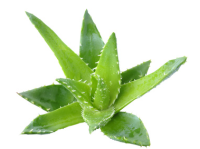Aloe Vera
 Overview
Overview
Many of the 120 known species of aloe are used as botanical medicines. The rind and sap parts of the aloe vera leaf have therapeutic components which act as anti-inflammatory compounds and analgesics. Aloe also contains minerals and beneficial fatty acids.
Aloe has been used since ancient times as a topical ointment for burns, wounds and other skin conditions and has been taken internally as a carminative, laxative, anthelmintic, an anti-inflammatory agent, and an aphrodisiac.
Chemical Components
The leaf of the aloe plant is used for medicinal purposes and is made into two distinct products: aloe resin/latex and aloe gel. The resin comes from the latex which comes oozing out of the leaf when it is cut. Aloe vera gel is produced when the central part of the leaf is broken or cut. Aloe gel which has been diluted is commonly referred to as aloe juice or aloe vera extract.
Aloe vera extract is composed mostly of water (some 99%) and mono- and polysaccharides. Aloe gel contains saponins, salicylic acid, sterols, lignans, triterpenoids, vitamins A, C, D, B12 and the minerals calcium, sodium, potassium, magnesium, manganese, copper, zinc, iron and chromium.
Uses
Widely known as a skin moisturizer and healing agent (in particular for burns), aloe can be used to treat cuts, stings from insects, acne, welts, poison ivy, bruises, eczema, skin lesions and sunburns. However, some people are not aware that aloe vera can also be taken internally to treat ulcers, colitis, stomach disorders and disorders which are related to the colon.
The juice from this versatile plant has also been used to treat varicose veins, arthritis, skin cancer and food allergies.
Some research suggests aloe vera may also have antiviral properties. Tests at the University of Maryland in Baltimore concluded that aloe vera emodin helped to inactivate herpes simplex virus type 1 and 2, pseudorabies virus, influenza and varicella-zostervirus.
Other research has shown that aloe vera contains anthraquinones, which can reduce the rate of growth of calcium crystals that lead to the formation of kidney stones. Also, once kidney stones are formed, aloe vera extracts have been known to reduce the size of kidney stones and often lead to elimination of the stones.
Dosage
Use aloe vera gel fresh from a living plant or drink 25 ml of aloe juice up to four times daily for optimum health benefits.
Adverse Reactions
While adverse reactions due to aloe vera use are rare, hypersentitivity and contact dermatitis have been reported in some people.
The use of aloe latex as a laxative for children is not recommended, nor should it be used by pregnant women. Persons who have an aloe sensitivity should not use this product, nor should individuals who are vomiting or showing signs of gastrointestinal obstructions.
References
- Bratman, S. The Alternative Medicine Ratings Guide: an expert panel rates the best treatments for over 80 conditions, Prima Health A Division of Prima Publishing (1998)
- Brown, L. Alternative Medicine, NTC/Contemporary Publishing (1999)
- Deepak Chopra, M.D. Alternative Medicine: The Definitive Guide, Celestial Arts (2002)
- Duke, J. The Green Pharmacy: Herbal remedies for common diseases and conditions from the world's foremost authority on healing herbs,Rodale Limited (2003)
- Nancy Allison. The Illustrated Encyclopedia of Body-Mind Disciplines, The Rosen Publishing Group (1999)
- Servan-Schreiber, D. The Encyclopedia of New Medicine: Conventional & Alternative Medicine For All Ages, Rodale International Limited (2006)
Posted in Aloe Vera
Ask a Question Or Join a Discussion


